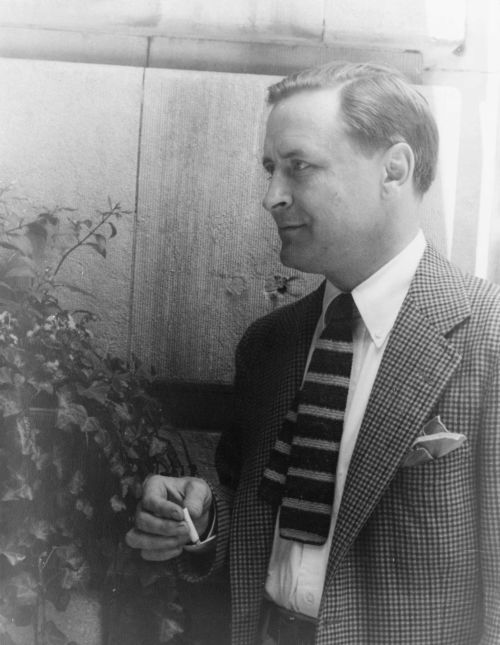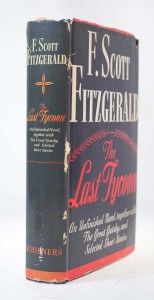“I have a dark impression that lingers—of a walk we took up the street at one day’s end. I was going to my car; he was going on to Schwab’s drugstore on Sunset Boulevard, just a couple of blocks away. He was wearing a dark topcoat and a gray homburg hat. As we kept pace, I looked over at him and was chilled by his image, like a shadowy figure in an old photograph. His outfit and pallor were alien to the style and warmth of Southern California—as if he were not at home here, had just stopped off and was dressed to leave on the next train.”
—Against the Current: As I Remember F. Scott Fitzgerald (1985)
If American author F. Scott Fitzgerald’s final moments were drafted into a screenplay, the scene might open something like this:
INT. SHEILAH GRAHAM’S HOLLYWOOD APARTMENT – DAY
A man, early 40’s but looks much older, wanders in his bathrobe into the living room where his lover, an attractive blonde, reads a book.
He struggles to open a candy bar recently purchased at Schwab’s Pharmacy then takes a generous bite. Chewing quietly, he wanders over to his armchair, the Princeton Alumni Weekly tucked under his arm.
A gasp. Suddenly, the man jumps out of the chair, dropping both the candy bar and newspaper. He reaches for the fireplace mantle, misses and tumbles to ground, unresponsive.
In a panic, his lover rushes out the door and soon returns with the building manager. He briefly inspects the lifeless body on the floor then turns his gaze to the woman.
BUILDING MANAGER
(quietly)
I’m afraid he’s dead.
That was December 21, 1940. Fitzgerald was only 44 years old. He had recently moved in with Sheilah Graham, a Hollywood gossip columnist with whom he was having an affair, to her small apartment around the corner from his own at North Hayward Avenue near Sunset Boulevard.
At the time of his death, Fitzgerald was far from the youthful, idealistic character often associated with his earlier novels, such as This Side of Paradise and The Great Gatsby. Unlike his fictional heroes, this man appeared fragile, subdued and even broken.

Physically, his body had already begun to fail him. Before this fatal heart attack, he survived two others, had reoccurring bouts of tuberculosis and struggled with alcoholism since his college days at Princeton.
Professionally, his writing career had stalled. His most recent novel, Tender Is the Night, flopped with critics and readers of the time. He moved to Hollywood in 1937 to try his hand at screenwriting. Living on meager film credits and short stories, he found himself in financial peril.
His personal life wasn’t faring any better. His wife, Zelda, once the crowned queen of flappers during the Jazz Age, suffered from mental illness and required institutionalization. The romantic, well-heeled and glamorous Fitzgeralds of the Roaring Twenties were largely forgotten.
There was one glimmer of hope … a new novel. Between booze binges and words for hire, Fitzgerald had been plugging along at his fifth manuscript, tentatively titled The Love of the Last Tycoon. Inspired by the life of real film producer and “boy wonder” Irving Thalberg, the book follows the rise and fall of fictional protagonist Monroe Stahr.
The text bubbles with early Hollywood history and local geographical references. At one point the dashing Monroe takes his love interest, Kathleen, on a car ride up an unfamiliar Pacific Coast Highway.
“Past Malibu with its gaudy shacks and fishing barges they came into the range of human kind again, the cars stacked and piled along the road, the beaches like ant hills without a pattern, save for the dark drowned heads that sprinkled the sea.”
—The Love of the Last Tycoon (1941)
Also mentioned in the book are references to the famous 1933 Long Beach earthquake that killed 115 people and caused millions of dollars in damage; communism’s influences in Hollywood circles; an early glimpse at wealthy enclave Bel-Air; and other fascinating fragments of Los Angeles past.
“Hollywood is a perfectly zoned city so you know exactly what kind of people economically live in each section from executives and directors, through technicians in their bungalows right down to extras.”
—The Love of the Last Tycoon (1941)

At the time he was writing The Love of the Last Tycoon, he employed a secretary by the name of Frances Kroll Ring. The young woman not only helped type drafts of the novel and projects, she became the author’s professional confidante, witnessing the ups and downs of his creative process. Her memories of these final months with Fitzgerald were shared in her book Against the Current: As I Remember F. Scott Fitzgerald.
I had the pleasure of meeting Ring twice, once at the F. Scott Fitzgerald Centennial Conference at Princeton University in 1996, where she entertained a mixed crowd of literary scholars and Fitzgerald fans, like myself, with stories from those days with her famous employer—whom she also often cooked and ran errands for. I fondly remember one such recount where she described gathering all his empty alcohol bottles, putting them in a large bag and tossing them off one of the canyons, probably Laurel.
My second meeting was at Burbank airport, where I recognized her with her daughter and expressed how much I admired her documentation of those days. Sadly, she passed away this year at age 99 here in Los Angeles. But her relationship with Fitzgerald lives on in the memoire.
He began to sort the notes that had been accumulating. He became transformed. The contrast was extraordinary—like watching an athlete who had let himself go to fat decide that he was going to make a comeback.
“He began to sort the notes that had been accumulating. He became transformed. The contrast was extraordinary—like watching an athlete who had let himself go to fat decide that he was going to make a comeback … he made charts of segments of the book and planned how long each segment would be. He divided the segments into episodes and the episodes into chapters. Assorted jottings and anecdotes were assigned to specific areas. Stray bits of description fell into place.”
—Against the Current: As I Remember F. Scott Fitzgerald (1985)
It was Ring who made final arrangements for Fitzgerald following his death. She put his affairs in order, paid his bills and even chose his simple coffin. His funeral, in Rockville, Maryland, just outside Washington D.C., was attended by about 30 people, including his daughter, Scotty.
The Love of the Last Tycoon, the comeback he so desperately wanted, laid on his desk unfinished. Fortunately, friend and literary critic Edmund Wilson took the incomplete manuscript and various pages of written plot notes to complete the book, published posthumously as The Last Tycoon in 1941. Director Elia Kazan and writer Harold Pinter adapted the story into a film starring Robert De Niro in 1976, and in 1993 editor and professor Matthew J. Bruccoli reassembled and republished the book as The Love of the Last Tycoon, the title Fitzgerald originally intended.
While the last years of Fitzgerald’s life may have been unfortunate, those following his death proved much kinder. The Great Gatsby, republished to great acclaim in the 1950s, endures as an American classic treasured by readers around the world, cementing the author as one of the greatest of his generation.
Fitzgerald may be immortalized as the young, vibrant personae of his most famous character, Jay Gatsby, but a small part of his legacy lives on in the shadows of Los Angeles. And like his other novels, The Love of the Last Tycoon reveals the darker side of the American Dream … this time set in the unforgiving Hollywood that witnesses his eventual demise. Yet like his final work, Fitzgerald’s story remains unfinished … subject to the interpretation of a next generation of dreamers.
Written by Darren Elms

















